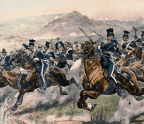

Fought on Sept. 17, 1631, the Battle of Breitenfeld was the first major Protestant victory of the Thirty Years’ War. The epic clash pitted the opposing factions’ most outstanding generals against one another. King Gustavus II Adolphus of Sweden commanded both his own Swedish forces and those of the Protestant Electorate of Saxony. Johann Tserclaes, Count of Tilly, commanded the combined forces of the Holy Roman empire and the Catholic League. Sparked by the Reformation, the war was among the costliest conflicts in European history, with combat, disease and famine claiming as many as 8 million soldiers and civilians. Neither Gustavus nor Tilly would live to see its conclusion.
Born in 1559 to devoutly Roman Catholic parents in Walloon Brabant (in present-day Belgium), Tilly fought Protestant Dutch rebels during the Eighty Years’ War (c. 1566–1648) and Ottoman Turks in Hungary and Transylvania in 1600. In 1610 Duke Maximilian I of Bavaria appointed the veteran field marshal commander of the Catholic League forces. From the outset of the Thirty Years’ War in 1618 Tilly’s impressive string of victories included the Battle of White Mountain (1620), the Battles of Wimpfen and Höchst (1622), the Siege of Heidelberg (1622), the Capture of Mannheim (1622), the Battle of Stadtlohn (1623), the Battle of Lutter (1626) and the nightmarish Sack of Magdeburg (1631). Tilly’s cavalry commander at both Magdeburg and Breitenfeld, four months later, was the fearsome Gottfried Heinrich, Count of Pappenheim. Together they formed one of the most dominating command combinations in the history of warfare.
Contrary to widespread belief, the Thirty Years’ War was far more complex than a strictly religious struggle between Catholics and Protestants, though it more or less started that way. With the signing of the Peace of Augsburg in 1555 subjects of the Holy Roman empire were required to follow the religion of their local princes. Most German princes around the turn of the 17th century were Protestant—either Lutheran or Calvinist—though the Duke of Bavaria was Catholic. Outside of Germany proper, most other members of the loosely knit empire, including Bohemia, much of northern Italy and Austria, were predominantly Catholic. The Austrian capital of Vienna was the seat of the empire.
In theory the emperorship was an elective,




